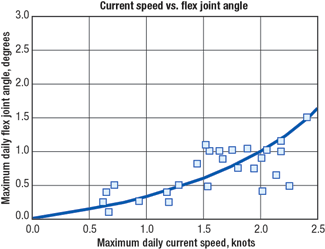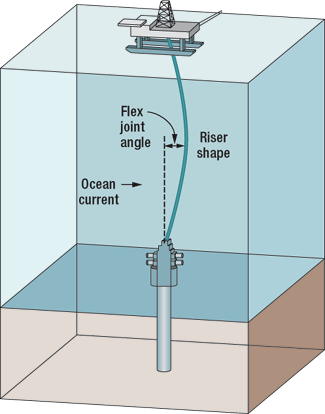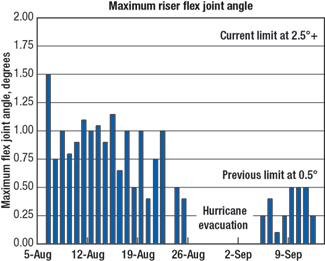Offshore Report
Extending the operational window during Gulf of Mexico Loop currents
Horizontal-reach technology overcomes downtime and riser wear.
Sarah Mitchell, Western Well Tool, Mike Reel, Rodney Littleton, Rick Cody and Hubert Stallings, Pioneer Natural Resources USA, Inc.
Drilling in deep water presents unique challenges. This is especially true in the Gulf of Mexico (GOM) where loop currents can exceed three knots. When operating from a floating drilling rig in 3,000-ft water depths or deeper, these currents place a great deal of stress on the riser, wellhead and subsea BOP/ wellhead systems, and also challenge the vessel’s ability to maintain position over the well.
On these rigs, the riser is held at two points: at the vessel and at the sea floor. The riser is attached at the surface by means of a ball joint assembly. The ball joint assembly is connected to motion compensators to maintain tension in the riser assembly. The riser column is secured to the sea floor assembly by means of a flex joint. Both the flex joint and ball joint provide a means for the riser to flex and absorb the movement and loads placed upon it in the course of drilling the well.
DEFLECTION CAUSES
Currents cause the riser to deflect through several mechanisms. First, the riser deflects in the direction of the current, because the current creates fluid drag. This drag increases as a square of the current velocity, so even small increases in current speed can have a significant impact on riser deflection, Fig. 1.
 |
Fig. 1. This graph demonstrates how current speed affected the riser flex joint deflection angle on a GOM well in over 3,500-ft water depth.
|
|
Second, the riser is subject to deflection from vortices that are shed from the riser as the current flows around its outside surface. The deflection caused by these vortices can often be difficult to predict.
Lastly, vessel movement and drift is a cause of riser deflection. This movement occurs regardless of whether the vessel is moored or dynamically positioned with thrusters.
As the riser flexes, the abrupt change of direction from vertical to the deflected position causes concentrated and severe point loads on both the drillstring and riser equipment, Fig. 2. As an example, based on finite element modeling, a ball joint on a 20,000-ft TVD well deflected at a 2° angle can create more than 7,000 lb of force between the ball joint and drill pipe. This load is enough to cause severe wear and damage to both the ball joint and flex joint, as well as related wear on the drilling riser while the pipe rotates and moves into and out of the hole.
 |
Fig. 2. This graphic shows a typical deflected shape, resulting in an abrupt transition from deflected to a vertical position as the riser meets the upper ball joint or lower flex joint.
|
|
Because of component wear and potential for drillstring, riser, and subsea equipment damage, drilling contractors often specify an angle beyond which the rig should halt drilling operations. This causes days and even weeks of delay, representing millions of dollars in lost rig time for operators drilling GOM wells from floating rigs.
 |
Fig. 3. This drawing shows how the protector prevents contact between the drill pipe and the ball joint.
|
|
OVERCOMING DOWNTIME
While drilling the GOM Green Canyon 299-1 well (Clipper prospect) from a semisubmersible in 3,500 ft-water depth, Pioneer Natural Resources USA, Inc. found a method to continue operations in currents that would have previously brought drilling operations to a halt. Previous protocols called for suspending operations when currents caused flex/ ball joint angles to exceed 0.5°.
At the start of the well, currents causing excessive flex joint angles resulted in downtime as the rig waited for conditions to improve before drilling operations could continue. For every well drilled, this resulted in millions of dollars wasted while waiting for currents to subside.
To solve this problem, Nonrotating Drill Pipe Protectors from Western Well Tool were installed to protect the riser, flex joint and ball joint. Pioneer had used these tools to good effect in 1994 in an Indonesian well with a wellhead deflection of 2.25° and decided to try them in this high-current, deflection situation offshore.
At the heart of the device is the sleeve, made from a tough, but flexible, polymer material. The sleeve is free to rotate on the pipe and its traditional use has been to reduce rotary torque, drag and casing wear in high-angle, extended-reach wells. The tool has an outside diameter greater than the drill pipe tool joint, so it creates a stand-off between the tool joint, which causes the most riser damage, and the well or riser bore. Drilling mud provides lubricity for the sleeve’s fluid bearing.
To ensure that the device would maintain a stand-off from the riser and associated equipment as the drill pipe flexed, engineers ran a finite element analysis on the assembly. The results indicated that the stand-off was maintained and that high contact forces were effectively transferred through the device, so that the rotating drillstring went through the ball joint without contact.
For this well, devices were installed on each drill pipe joint covering the entire riser. Up to three protectors per drill pipe were needed per pipe length, depending on the sideloads expected. Protectors were installed 18 in. above the joint pin, another device about a foot above the first one and, if needed, a third protector in the middle of the drill pipe segment. To protect 9,000 ft of pipe, 600 – 800 protectors were needed. The protectors distributed the concentrated loads while drilling and allowed for a greatly expanded operating envelope.
Based on the results from this well, flex/ ball joint angles no longer limit drilling operations. The limiting factor in high-current operations now becomes the mooring system.
As a savings example, during a 27-day drilling period, 15 days (55%) would have resulted in interrupted operations because flex/ ball joint angles exceeded 0.5 degrees, Fig. 4. The downtime percentage for this well is higher than typical, but it demonstrates the potential to reduce costs and increase drilling time by using technology that permits continuous, uninterrupted operation.
 |
Fig. 4. Of the rig’s 27 days on station, fifteen (55%) would have caused delay because flex/ ball joint angles exceeded 0.5°.
|
|
In previous wells in the area, there were 20 lost days on average due to currents and riser deflection. The device’s use allowed drilling through the entire period and shaved two weeks off the time needed to drill the well.
At rig rates of $300,000 per day, the savings on this well was more than $4.5 million over the time the devices were installed. This was only a portion of the total time that loop currents affected operations on the rig. After completion of the well, an inspection of the drilling riser, subsea BOP and flex/ ball joint package showed that the sleeves prevented wear or damage to the components. 
|
THE AUTHORS
|
| |
Sarah Mitchell has been a product engineer with Western Well Tool since 2000. She received her degree in Materials Engineering in 1997 from California Polytechnic State University at San Luis Obispo.
|
|
| |
Mike Reel is worldwide drilling and completions supervisor for Pioneer Natural Resources. He has 31 years of supervisory experience in international and domestic deepwater and land drilling and completion operations. He correctly challenged the results of the one dimensional, current-affected, riser model and proved it was not accurate.
|
|
|
Rodney Littleton is GOM deepwater and international land drilling superintendent for Pioneer Natural Resources. He has 25 years’ experience engineering and operations. Littleton earned a BS in geological engineering from the University of Missouri at Rolla.
|
|
|
Rick Cody is a deepwater and land drilling and completions consultant for Pioneer Natural Resources. He has 24 years’ experience engineering and operations. He holds a BS degree in chemical engineering from Texas A&M University. He conceived the concept for the use of the NRPPs.
|
|
|
Hubert Stallings is worldwide drilling and completions supervisor for Pioneer Natural Resources. He has 35 years of supervisory experience in deepwater and land drilling and completion operations.
|
|
|






